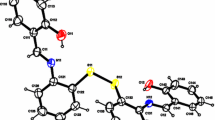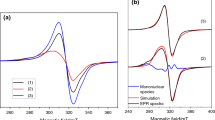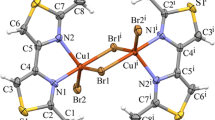Summary
The SOD-like activity of Cu(III) -complexes with polypeptides poly-L-lysine and poly-L-glutamic acid respectively was investigated. The Cu(II)-polypeptide complexes were first oxidized by K2IrCl6 to give the corresponding Cu(III) -compounds.
The oxidation of Cu(II) and the corresponding Cu(II)/Cu(III) potential was evaluated by cyclic voltammetry (c.v.), UV-Vis and EPR spectroscopic (r.t.) experiments. Spin trapping EPR spectra were also conducted to confirm the formation of the superoxide radical. The SOD-like activity of each Cu(III)-complex was proved using the nitro blue tetrazolium (NBT) method slightly modified.
Similar content being viewed by others
References
Arena G, Rigano C, Rizzarelli E, Sammartano S (1979) A non-linear least squares approach to the refinement of all parameters involved in acid-base titrations. Talanta 26: 1–5
Beauchamp C, Fridovich I (1971) Superoxide Dismutase: improved assays and an assay applicable to acrylamide gels. Anal Biochem 44: 276
Bonomo RP, Conte E, Marchelli R, Santoro AM, Tabbi G (1994)\(O^-- _{\dot 2} \) Scavenger properties of Copper (II) complexes with diamino-diamide-type ligands. J Inorg Biochem 53: 127–138
Bossu FP, Chellapa KL, Margerum DW (1977) Ligand effects on the thermodynamic stabilization of copper (III)-peptide complexes. J Am Chem Soc 99: 2195–2203
Britigan BE, Rosen GM, Chai Y, Cohen MS (1986) Do human neutrophils make hydroxyl radical? Determination of free radicals generated by human neutrophils activated with a soluble or particulate stimulus using EPR spectrometry. J Biol Chem 261: 4426–4431
Cao R, Travieso N, Fragoso A, Villalonga R, Diaz A, Martinez ME, Alpizar J, West DX (1997) Determination of SOD-like activity of copper (II). Complexes with a-amino acid dithiocarbamates. J Inorg Biochem 66: 213–217
Gran G (1952) Determination of the equivalence point in potentiometric titrations. Analyst 77: 661–671
Mc Cord J, Fridovich I (1969) An enzymic function for erythrocuprein (hemocuprein). J Biol Chem 244: 6049–6055
Ramadan AM, El-Naggar MM (1996) Synthesis, characterization and demonstration of SOD-like activity of copper (II) chloride, bromide, nitrate, thiocyanate, sulphate and perchlorate complexes with 2-methyl-amino pyridine. J Inorg Biochem 63: 143
Sichel G, Corsaro C, Scalia M, Di Bilio AJ, Bonomo RP (1991) A new method for superoxide radical production. J Free Rad Biol Med 11: 276–282
Author information
Authors and Affiliations
Rights and permissions
About this article
Cite this article
Liakopoulou-Kyriakides, M., Hadjispyrou, S. & Zarkadis, A. Cu(III)-Polypeptide complexes exhibiting SOD-like activity. Amino Acids 16, 415–423 (1999). https://doi.org/10.1007/BF01388180
Received:
Accepted:
Issue Date:
DOI: https://doi.org/10.1007/BF01388180




